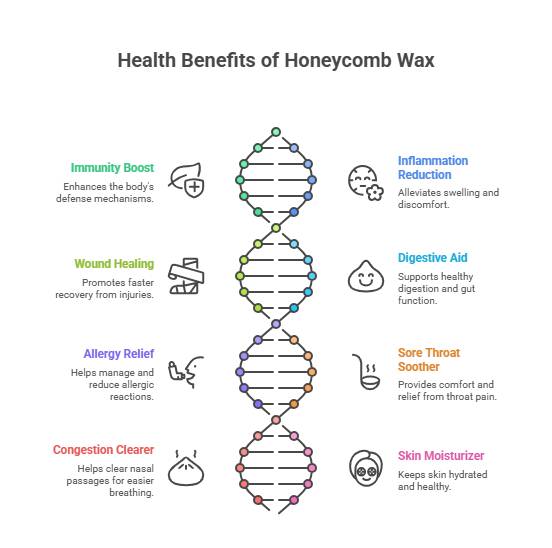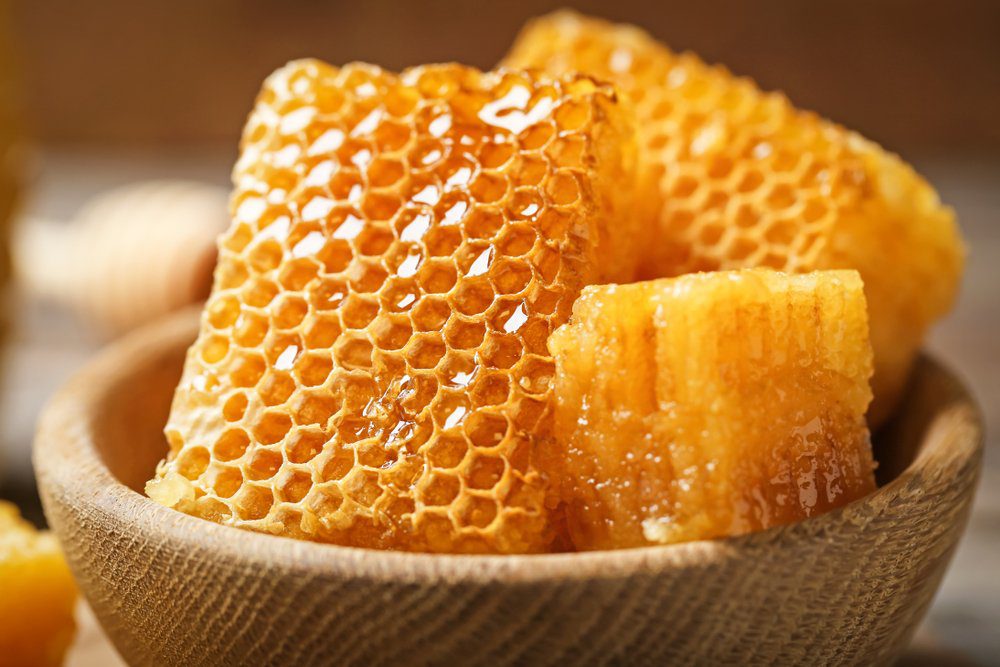Honeycomb wax is a natural and sustainable product that has been used for centuries for many different purposes. It’s made from the wax of honeybees, and its unique properties offer numerous health benefits. Honeycomb wax is rich in vitamins, minerals, antioxidants, and other essential nutrients that can help to improve overall health and well-being.
From improving digestive health to promoting skin health, the health benefits of honeycomb wax are often overlooked but should not be underestimated. In this article, we will explore the hidden health benefits of honeycomb wax and how it can improve your life.
What is honeycomb wax made of?
Honeycomb wax is a type of wax made from beeswax, which is produced by honeybees as part of their natural hive-building process. The wax is created when the bees produce secretions from four pairs of glands on their abdomens and then mix these secretions with pollen and other substances that they store in the comb.
The result is a solid form of wax, which is then used to construct the walls of their hives. Honeycomb wax is a natural product and an important component of the bee’s diet. It contains numerous beneficial compounds and is often used in a variety of cosmetic and health products.
Primary Components.
The primary components of honeycomb wax are:
1. Beeswax.
This is a natural wax produced by bees and is composed mainly of hydrocarbons such as alkanes, alkanoic acids, and long-chain alcohols.
2. Propolis.
This is a resin-like substance created from the sap of certain trees and plants. It acts as a natural antibiotic, anti-fungal, and antiseptic agent.
3. Pollen.
This is a nutritious powder-like substance that the bees collect from flowers and use as food for their young. It also provides essential nutrients to the hive, such as proteins, vitamins, minerals, and antioxidants.
4. Royal Jelly.
This is a substance secreted by worker bees that is high in proteins, vitamins, and amino acids. It is used to feed larvae and help them grow into strong adult bees.
5. Nectar.
This is a sweet liquid collected by the bees from flowers to feed their young. It also provides them with energy and helps them build honeycombs.
These are the main components of honeycomb wax and each one has its own unique set of health benefits.
Read Now: Kiat Jud Dai Workout Step by Step With Benefits And Reviews
Health Benefits of Honeycomb Wax.
1. Boosts Immunity.
One of the health benefits of honeycomb wax is that it can boost your immunity. This is because of its powerful antioxidant and anti-inflammatory properties. It has been found to contain polyphenols, flavonoids, and antioxidants which help to protect the body from damage caused by free radicals.(1)
Honeycomb wax also has antiviral, antimicrobial, and antifungal properties which help to fight off any infection or illness. By boosting your immunity, you can prevent illnesses and keep your body healthy.

2. Reduces Inflammation.
Honeycomb wax has long been used as a natural remedy for reducing inflammation in the body. Studies have shown that honeycomb wax contains high levels of antioxidants, which help fight off free radicals that can lead to inflammation. In addition, the honeycomb wax itself has anti-inflammatory properties that can help to reduce inflammation in the body, providing relief from pain and other symptoms.(2)
When applied directly to the skin, honeycomb wax can be used to reduce swelling, redness, and irritation. When taken internally, honeycomb wax can help to reduce inflammation in the digestive system, helping to improve digestion and absorption of nutrients.
3. Heals Wounds.
Honeycomb wax is an amazing natural remedy for healing wounds. It has antiseptic, anti-inflammatory, and antibacterial properties, making it an ideal choice for wound care. Honeycomb wax helps to keep wounds clean and infection-free by providing a protective barrier against bacteria and other contaminants.(3)
It can also reduce inflammation and promote faster healing. Honeycomb wax is also known for its pain relief properties, making it ideal for healing cuts and scrapes. Additionally, it’s said to reduce the amount of scarring caused by wounds, making it a great choice for healing minor wounds. Honeycomb wax is a safe and natural remedy that can be used to heal wounds with minimal risk of side effects.
4. Eases Digestion.
Honeycomb wax has been used for centuries to treat digestive problems. The wax helps to coat and protect the lining of the stomach, which can help soothe irritation and improve digestion. Honeycomb wax is also thought to stimulate the secretion of digestive juices, including bile and enzymes, that aid in the digestion process.

Additionally, honeycomb wax may help ease symptoms associated with gastrointestinal conditions such as irritable bowel syndrome (IBS). Studies have shown that honeycomb wax can reduce abdominal cramps, bloating, and constipation. If you suffer from digestive issues, honeycomb wax could be a natural solution to help ease your symptoms.(4)
5. Fights Allergies.
Honeycomb wax is packed with anti-inflammatory and antibacterial properties, making it an effective remedy for allergies. The wax contains high amounts of bioactive compounds, including propolis and flavonoids, which are known for their ability to reduce inflammation and provide relief from allergic reactions.
Studies have also shown that it can help reduce the symptoms associated with seasonal allergies, such as runny nose, sneezing, and watery eyes. It works by inhibiting the release of histamines, which are the body’s natural defense against allergens.(5)
Additionally, it can help reduce the severity of hay fever and other allergic reactions. By consuming honeycomb wax regularly, you can help reduce your risk of developing allergies and keep your immune system strong.

6. Soothes a Sore Throat.
Sore throats can be an annoying and painful nuisance, but luckily, honeycomb wax may help soothe the discomfort. Honey is known for its healing and antibacterial properties, and when combined with the other natural ingredients in honeycomb wax, it helps to coat and protect your throat. Honeycomb wax is also naturally high in Vitamin C, which helps to reduce inflammation and can provide relief from sore throats.(6)
Additionally, the anti-inflammatory properties of honeycomb wax make it a great choice for treating inflamed throats caused by infections or allergies.
To use honeycomb wax for soothing a sore throat, simply take a tablespoon of the wax and dissolve it in warm water. This mixture can then be taken up to three times a day as needed. With regular use, honeycomb wax can provide relief from sore throats within a few weeks..
7. Clears Congestion.
Honeycomb wax is well known for its ability to clear congestion and provide relief from nasal and sinus issues. The wax acts as a natural antihistamine, helping to reduce inflammation in the airways and make breathing easier. It also helps to thin mucus and allow it to move through the respiratory system more easily.(7)
Furthermore, honeycomb wax contains natural antimicrobial and antibacterial properties that help to fight infection in the respiratory tract. All these benefits make honeycomb wax a great choice for those suffering from seasonal allergies or any kind of congestion.
8. Moisturizes Skin.
The healing properties of honeycomb wax are not limited to its medicinal benefits, as it is also great for moisturizing your skin. The wax contains natural humectants, which attract moisture from the air and help to keep your skin hydrated.(8)

Additionally, the wax forms a protective barrier that prevents moisture from evaporating from the skin. This makes it especially helpful for people with dry skin, eczema, or psoriasis. Honeycomb wax can be used directly on the skin as a moisturizer, or can be added to lotions and creams for additional hydration. As a bonus, the anti-bacterial properties of honeycomb wax can help to reduce acne and other blemishes.
Side Effects of Honeycomb Wax.
1. Skin Irritation.
Some people may experience skin irritation when using honeycomb wax. This can occur when the wax is applied too close to the skin or if it is used too often. It is important to test the product on a small area of skin before using it on a larger area and to use it as directed.
2. Allergic Reactions.
Those with allergies to bees or other products derived from bees may have an allergic reaction to honeycomb wax. If you notice any signs of an allergic reaction such as itching, hives, or difficulty in breathing, discontinue use immediately and seek medical attention.
3. Eye Irritation.
Honeycomb wax can cause eye irritation if it comes in contact with the eyes. To avoid this, take caution not to get the wax in your eyes when applying and wash your hands thoroughly after use.
4. Chemical Burn.
When heated, honeycomb wax can cause chemical burns due to its high concentration of acids and other chemicals. Always use caution when heating the wax, and make sure to keep it away from sensitive areas like the face and eyes.
5. Burning Sensation.
Some users may experience a burning sensation after using honeycomb wax. If this occurs, it is important to reduce the frequency of use and consult a doctor if the burning sensation does not subside after a few days.
How to Eat Honeycomb Wax?
Eating honeycomb wax is a delicious and healthy way to get the benefits of the natural compounds and minerals found in this product. There are several different ways to enjoy honeycomb wax.
One of the simplest and most traditional ways to consume honeycomb wax is to simply eat it plain, without any other ingredients. Honeycomb wax is soft and easily breakable, so you can simply break off a piece, let it melt on your tongue and enjoy the rich, sweet flavor. This method is ideal for those who want to experience all of the unique flavors that each type of honeycomb wax has to offer.

If you’re looking for something a little sweeter, you can also add honeycomb wax to your favorite recipes. For example, you can add it to smoothies, yogurt, oatmeal, or even ice cream. You can also mix it with honey and spread it onto toast, pancakes, or waffles. Alternatively, you can also sprinkle some onto fruits such as apples or strawberries for an extra sweet kick.
Lastly, you can also use honeycomb wax in your baking recipes. It adds a delicious sweetness to cakes, muffins, and other baked goods. You can also make honeycomb wax-infused teas or even alcoholic drinks. Just be sure to add a small amount of honeycomb wax at a time to avoid an overly sweet taste.
note. No matter how you choose to enjoy honeycomb wax, you can be sure that you’re getting all of the wonderful health benefits that it offers. Whether you eat it plain, add it to your favorite recipes, or use it as an ingredient in baking, you’ll be sure to enjoy the unique flavor and texture of this delicious product.
How Much To Eat?
The amount of honeycomb wax you can eat depends on your individual needs. Generally speaking, you should only consume up to two tablespoons of honeycomb wax per day. However, if you are taking any medication, have a medical condition, or are pregnant or breastfeeding, it is important to speak with your doctor first before consuming any honeycomb wax.
Eating too much honeycomb wax can cause side effects such as nausea, vomiting, and diarrhea. Additionally, it is important to note that honeycomb wax can interact with certain medications, so you should always consult with a healthcare professional before consuming large amounts of it.
If you do decide to try eating honeycomb wax, it is best to start with small amounts and gradually increase the dosage until you find the right amount for you. Additionally, it is always important to buy high-quality products and store them in a cool, dry place.
Expert Insight: The Facts of the Matter.
According to Dr. Meera Bansal, Nutritionist & Ayurvedic Health Specialist:
Honeycomb wax in its raw form is basically one of the most unrefined things that you can get from nature — it totals to a pretty impressive list of things: enzymes, antioxidants, and friendly compounds. Along with that, honeycomb chewing might be a good way to alleviate the throat, enhance the immune system, and eventually help digestive health too. The thing is, ‘moderation is key’ though. If one eats too much, sugar intake will definitely be increased, and people who are allergic to pollen or bee products should not take it. For the majority of healthy persons, small doses of natural honeycomb can easily become both a healthy and a pleasurable part of the lifestyle.
Token Message.
Honeycomb wax is a natural product that offers many health benefits when used correctly. It boosts immunity, reduces inflammation, heals wounds, eases digestion, fights allergies, soothes a sore throat, clears congestion, and moisturizes the skin. Despite the many benefits, there are a few side effects that you should be aware of before using honeycomb wax.
If you decide to use honeycomb wax for its health benefits, remember to take it in moderation and always follow the directions on the package for the best results. To eat honeycomb wax, you can add it to smoothies, yogurt, oatmeal, or salads for a hint of sweetness.
+8 Sources
Verywelfit has strict sourcing guidelines and relies on peer-reviewed studies, educational research institutes, and medical organizations. We avoid using tertiary references. You can learn more about how we ensure our content is accurate and up-to-date by reading our editorial policy.
- Honey and Health: A Review of Recent Clinical Research; https://pubmed.ncbi.nlm.nih.gov/28539734/
- Honey and its nutritional and anti-inflammatory value; https://www.ncbi.nlm.nih.gov/pmc/articles/PMC7807510/
- Honey in wound healing: An updated review; https://www.ncbi.nlm.nih.gov/pmc/articles/PMC8496555/
- Honey, Propolis, and Royal Jelly: A Comprehensive Review of Their Biological Actions and Health Benefits; https://www.ncbi.nlm.nih.gov/pmc/articles/PMC5549483/
- Ingestion of honey improves the symptoms of allergic rhinitis: evidence from a randomized placebo-controlled trial in the East Coast of Peninsular Malaysia; https://www.ncbi.nlm.nih.gov/pmc/articles/PMC6074882/
- Traditional and Modern Uses of Natural Honey in Human Diseases: A Review; https://www.ncbi.nlm.nih.gov/pmc/articles/PMC3758027/
- Common Respiratory Diseases; https://www.ncbi.nlm.nih.gov/pmc/articles/PMC7119334/
- Bee Products in Dermatology and Skin Care; https://www.ncbi.nlm.nih.gov/pmc/articles/PMC7036894/
How we reviewed this article:
Our team of experts is always monitoring the health and wellness field, ensuring that our articles are updated promptly as new information emerges. See Our Editorial Process
Nov 16, 2025
Written By: Nebadita
Reviewed By: Roxana Ehsani
Written By: Nebadita
Reviewed By: Roxana Ehsani

 Workout
Workout
 Meditation
Meditation





 Contact Us
Contact Us














